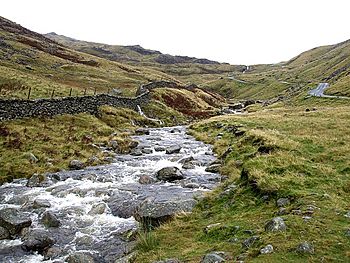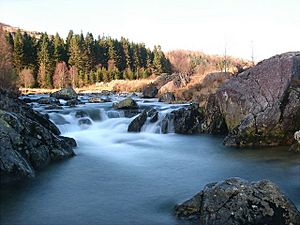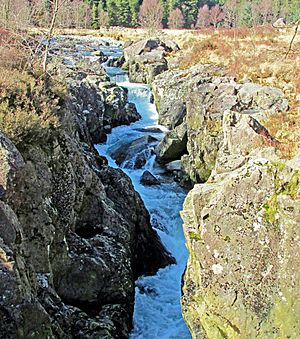River Duddon facts for kids
Quick facts for kids Duddon |
|
|---|---|

The Duddon flowing down Wrynose Pass
|
|
| Country | England |
| Region | Cumbria |
| Physical characteristics | |
| Main source | southern slopes of Pike of Blisco 500 m (1,600 ft) 54°25′11″N 3°07′00″W / 54.4196°N 3.1168°W |
| River mouth | Irish Sea Duddon Sands 0 m (0 ft) 54°10′12″N 3°19′30″W / 54.1700°N 3.3250°W |
| Length | 43 km (27 mi) |
The River Duddon is a beautiful river located in the north-west of England. It starts high up in the mountains, about 500 meters (1,640 feet) above sea level. This starting point is near the Three Shire Stone on Wrynose Pass.
The river flows for about 43 kilometers (27 miles) before it reaches the Irish Sea. It ends in a wide area called the Duddon Sands. For its entire journey, the Duddon forms the border between two historic areas: Lancashire and Cumberland. Since 1974, the whole river has been within the county of Cumbria.
Contents
Exploring the River Duddon's Journey
The River Duddon collects water from a large area known as its catchment. This area includes many hills and mountains in the south-western Lake District. Some of these are the eastern slopes of Corney Fell and Ulpha Fell. It also includes Harter Fell and the mountains around the top of Langdale.
From Source to Sea: The River's Path
From where it begins, the Duddon drops quickly over about 3.2 kilometers (2 miles). It flows down to a place called Cockley Beck at the start of Dunnerdale. Near the small village of Seathwaite, another stream called Tarn Beck joins the Duddon. This stream comes from Seathwaite Tarn.
The river then turns southwest, flowing towards Ulpha Bridge. After passing under the main road of the Duddon Valley, it turns south. It continues until it reaches Duddon Bridge, where the A595 road crosses over it. About 1.6 kilometers (1 mile) after this, the Duddon becomes tidal. This means the ocean's tides start to affect its water level. Here, it widens into the Duddon Estuary, located between Furness and south-west Cumberland.
Famous Writers and the Duddon
The River Duddon and its estuary have been a source of inspiration for many writers. These artists found beauty and meaning in its landscapes.
Norman Nicholson's Connection
The Cumbrian poet Norman Nicholson loved the Duddon. He often wrote about the river and its estuary in his poems. He once said that the Duddon Valley was his "favourite place of all." He found it full of variety and interesting details.
Arthur Ransome's Fictional Valley
The famous author Arthur Ransome also featured the Duddon Valley in his "Lake novels." He gave it a different name in his books, calling it ‘Dundale.’ His stories often involved children exploring the natural world.
William Wordsworth's Sonnets
The well-known poet William Wordsworth wrote a lot about the Duddon. He knew and loved this river from when he was young. Between 1804 and 1820, he wrote a series of poems called "The River Duddon, A Series of Sonnets."
These poems were first published in 1820. They started with 33 sonnets, but later, in 1827, he added one more, making it 34 sonnets. Each sonnet followed the river's path, from its source to the sea. For example, Sonnet XI mentions Birks Bridge, and Sonnet XXII describes Ulpha. Sonnet XXXII talks about the river reaching "the Deep...over smooth flat sands."
Fun Activities on the Duddon
The River Duddon offers several ways for people to enjoy the outdoors. It is a great place for fishing and canoeing.
Fishing for Salmon
The River Duddon is known as a good place for salmon fishing. Many people enjoy trying to catch salmon in its waters.
Canoeing Adventures
Canoeing is also popular on the Duddon. The part of the river downstream from Seathwaite is good for canoeists. It is rated as "Grade 3," which means it has some exciting rapids. Some parts, like from Birks Bridge through Troutal Gorge to Seathwaite, are more challenging. These sections are rated "Grade 5" and need higher water levels to be navigated safely.
Visiting the Duddon Valley
Many visitors come to the Duddon Valley, but it is not as crowded as other parts of the Lake District. Most people who visit are day trippers from nearby areas in northern England. This quieter nature is one of its main attractions.




